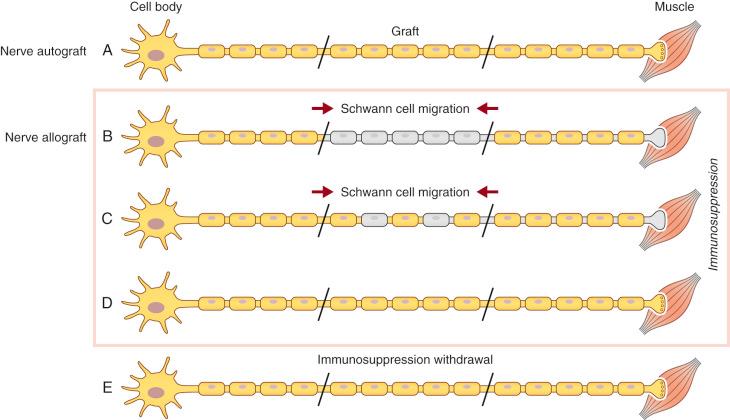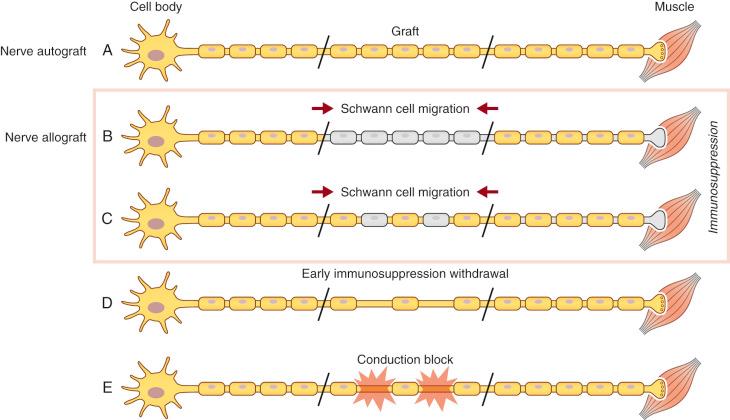Physical Address
304 North Cardinal St.
Dorchester Center, MA 02124
Peripheral nerve injuries are common and can be functionally devastating. Improved understanding of nerve topography, injury, and regeneration has led to advances in peripheral nerve surgery and increased treatment options for our patients.
Traditionally, when a tensionless repair cannot be performed, a nerve autograft is employed to bridge the defect. However, autografts can be associated with additional surgical sites, increased operative time for harvesting, and potential donor site morbidity, including sensory loss, scarring, and debilitating neuroma formation. Further, in the cases of large, segmental or multiple limb injuries, the amount of expendable autograft becomes a limitation. For these reasons, alternatives including nerve allotransplantation and processed nerve allografts were developed.
More recently, vascularized composite tissue allotransplantation has become a reality for the treatment of devastating injuries involving traumatic amputations or significant facial disfigurement. Since 1998, over 100 hand and 30 face transplants have been performed, with published reports of 72 hand and 19 face transplantations. The function of these transplanted parts is dependent on specificity and efficacy of the nerve regeneration. The purpose of this chapter is to explore and review nerve autograft alternatives. Specifically, we focus on the biology of nerve allografts, review the clinical experience of nerve allotransplantation, and discuss nerve regeneration in the setting of vascularized composite allotransplantation (VCA). We will also briefly describe the clinical evidence for the use of nerve conduits and processed nerve allografts.
A peripheral nerve injury initiates a highly regulated and sophisticated sequence of events. This process is dependent on the degree of nerve injury. Establishing the severity of the injury will help predict if recovery is possible and if surgical intervention is needed. Seddon first classified nerve injury into neurapraxia, axonotmesis, and neurotmesis. Sunderland and Mackinnon later revised the classification system ( Table 68.1 ). A neurapraxia involves localized myelin damage. The axon is preserved and thus the nerve does not undergo degeneration. Axonal disruption, in contrast, leads to Wallerian degeneration distal to the site of injury with coordinated activation of Schwann cells (SCs) and macrophages to remove myelin and axonal debris.
| Seddon | Sunderland | Description | Recovery |
|---|---|---|---|
| Neuropraxia | I | Conduction block | Spontaneous recovery |
| Axonotmesis | II | Axonal Injury | Spontaneous recovery |
| III | Axonal and Endoneurium Injury | Partial recovery without surgical intervention | |
| IV | Axonal, Endoneurium, and Perineurium Injury | No recovery without surgical intervention | |
| Neurotmesis | V | Axonal, Endoneurium, Perineurium, and Epineurium Injury (Nerve Transection) | No recovery without surgical intervention |
| VI | Mixed pattern injury | Mixed recovery based on injury pattern |
Proximal to the injury, mitogenic cytokines released by the injured axons induce SCs to change into a proliferating phenotype. These proliferating SCs organize into columns along the basement membrane of endoneurial tubes and are referred to as “bands of Büngner” and they support axonal regeneration. Axons are initially pruned and then begin to sprout and regenerate along these bands to reestablish nerve continuity and reach the end-organ target. In humans, this regenerative rate is reported to occur at 1–3 mm/day.
Segmental nerve defects or tension at the site of injury will disrupt the normal cascade of events preventing regeneration. Traditionally, interposed autografts have served as a bridge or structural framework to allow regeneration to proceed and are considered the gold standard. They provide the necessary medium for regeneration, including viable SCs and extracellular matrix, despite undergoing Wallerian degeneration themselves. Autografts are typically chosen based on their caliber, the length of the nerve gap, donor site morbidity, and ease of harvest. Due to the ease of harvest, the long length, and minimal donor site morbidity, one of the most commonly used autografts is the sural nerve. Other suitable nerves for interpositional grafts are reviewed in Table 68.2 .
| Nerve graft | Potential length | Characteristics |
|---|---|---|
| Sural | 30–40 cm | Formed from the medial cutaneous sural nerve originating from the tibial nerve |
| Common donor nerve | ||
| Descends the leg between the two heads of the gastrocnemius becoming superficial just before it is joined by the sural communicating branch off the peroneal nerve | ||
| The donor defect involves the lateral and posterior part of the lower third of the leg but decreases in size over time | ||
| Medial antebrachial cutaneous | 20 cm | Travels down the arm medial to the brachial artery then becomes superficial to the deep fascia in the middle of the arm and runs distally with the basilica vein |
| Typically bifurcates proximal to the medial epicondyle into anterior and posterior branches | ||
| Harvesting the anterior branch avoids loss of sensation over the elbow | ||
| Lateral antebrachial cutaneous | 5–8 cm | Distal continuation of the musculocutaneous nerve |
| Exits from under the biceps tendon and splits into an anterior and posterior branch, running with the cephalic vein | ||
| Sensory defect involves the anterolateral forearm but can involve the volar radial or dorsoradial thumb | ||
| Significant or total overlap of sensory innervation with the superficial sensory radial nerve | ||
| Posterior cutaneous nerve of the forearm | 2–5 cm | Sensory branch of the radial nerve |
| Arises from the radial nerve in the spiral groove and passes through the lateral head of the triceps | ||
| Descends down the lateral aspect of the arm and terminates at the dorsal forearm and wrist | ||
| Provides sensation to the posterolateral forearm and is rarely used | ||
| Superficial radial nerve | 15–20 cm | Prone to painful neuroma formation, therefore not a first-line choice |
| It may be used for proximal radial nerve injuries | ||
| Separates from the radial nerve just distal to the elbow | ||
| Becomes superficial as it wraps around the brachioradialis 7 cm proximal to the wrist crease | ||
| Sensory defect corresponds to the dorsum of the thumb and the 1st and 2nd web spaces | ||
| Dorsal sensory branch of the ulnar nerve | 4–6 cm | Appropriate size and length for use as a digital nerve |
| Takeoff from the ulnar nerve 5 cm proximal to the wrist | ||
| Travels along the dorsomedial aspect of the wrist before dividing into two or three terminal dorsal branches | ||
| Painful neuroma formation is not typical | ||
| Donor defect involves the dorsal ulnar wrist, hand, and proximal parts of the ulnar two fingers | ||
| Posterior interosseous nerve | 6 cm | Terminal portion of the PIN provides wrist joint capsule proprioception |
| Lies deep to the 4th extensory compartment | ||
| Good donor for digital nerve defects | ||
| No apparent motor or sensory defect | ||
| Anterior interosseous nerve | 7 cm | Terminal portion of the AIN provides wrist joint capsule proprioception and innervates the pronator quadratus |
| Lies adjacent to the anterior interosseous artery on the volar aspect of the interosseous membrane as it enters the pronator quadratus | ||
| No clinically apparent motor or sensory defect | ||
| Superficial peroneal nerve | 30–35 cm | Major lateral branch of the common peroneal nerve innervating the peroneus longus and brevis, in addition to providing sensation to the lateral aspect of the lower leg and dorsal foot |
| Consistently long graft | ||
| Donor defect motor and sensory | ||
| Saphenous nerve | 40 cm | Largest cutaneous branch of the femoral nerve |
| Becomes subcutaneous between the sartorius and gracilis tendons | ||
| Advances down the leg next to the saphenous vein | ||
| Donor defect involves the medial aspect of the lower leg | ||
| Do not take the saphenous and sural nerve from the same leg as their cutaneous innervation overlaps and the resulting donor defect is significant | ||
| Intercostal nerves | 20 cm | Mixed motor/sensory nerve innervating accessory respiratory muscles of the thoracic wall and overlying skin |
| Donor site incision can be large and invasive | ||
| Risk of pneumothorax | ||
| Avoid harvesting T4 intercostal nerve to preserve sensation to nipple areola complex | ||
| Lateral cutaneous nerve of the thigh | 10–20 cm | Donor defect involves loss of sensation to the anterolateral aspect of the thigh. |
In large, segmental, complex, or multi-limb nerve injuries, the amount of available autograft sources may be limited. Nerve allografts, from either a cadaver or living donor provide an abundant source of nerve graft. They also avoid the donor site morbidity of nerve autografts, but require systemic immunosuppression for their use. In the presence of adequate immunosuppression, nerve allografts provide equal regeneration and function of an autograft. Studies even demonstrate enhanced regeneration in nerve allografts due to the regeneration-enhancing effects of the immunosuppressant, tacrolimus.
Systemic immunosuppression has known risks. These include, but are not limited to, increased risk for opportunistic infections, nephrotoxicity, and decreased cancer immunosurveillance, resulting in malignancy. Due to the toxicity and risks of immunosuppression, the indication for nerve allografts has been narrow, and careful selection of the patients is important. Currently, nerve allotransplantation is reserved for unique clinical situations of devastating nerve injuries that are not amenable to nerve transfers or nerve autografting, and conservative management would result in a nonfunctional limb or nonmanageable pain.
Nerve allotransplantation is unique when compared with solid organ and composite tissue transplantation. The nerve allografts act as a biological and temporary conduit through which host motor and sensory axons traverse to reach the host end-organ target. Thus, nerve allografts require only temporary systemic immunosuppression, which can be withdrawn once the axons have crossed the allograft.
As previously discussed, SCs are an integral part of injured axonal recovery as they provided both neurotrophic factors and structural integrity. In both nerve autografts and allografts, SCs are essential for supporting axonal regeneration and subsequent remyelination. In nerve allografts, both donor and host SCs proliferate and support axonal regeneration as long as adequate immunosuppression is present ( Fig. 68.1A ).

Host SC migration is essential in the process of nerve regeneration across a nerve allograft. It occurs from both the proximal and distal nerves. Eventually, donor SCs are lost, despite adequate immunosuppression, but this is from an unclear mechanism and may involve chronic rejection or episodes of subtherapeutic immunosuppression. Our laboratory explored SC migration and found, under immunosuppression, host SC migration into the graft is delayed. However, after regeneration was completed and immunosuppression was stopped, host SC migration occurred immediately to fill in the gaps left by the loss of the rejected donor SCs along the graft ( Fig. 68.1E ).
SCs are also known to play a large immunogenic role in nerve allograft rejection. They express major histocompatibility complex I (MHC-I), a molecule on cellular membranes that is responsible for displaying fragments of intracellular proteins to T cells to either trigger or prevent an immune response. Transplanted SCs also increase their expression of MHC II molecules, a family of molecules found on antigen-presenting cells and B-cell lymphocytes, increasing their host rejection response. For this reason, SCs are recognized as a prime target of the host alloimmune response. Because SCs play a large role in both axonal regeneration and allograft rejection, immunosuppression cannot be safely withdrawn until regeneration has reached the end-target organ. Functionally, removal of immunosuppression prior to repopulation of the donor graft by host SCs will result in donor SC death and a subsequent, devastating conduction block ( Fig. 68.2 ).

Become a Clinical Tree membership for Full access and enjoy Unlimited articles
If you are a member. Log in here